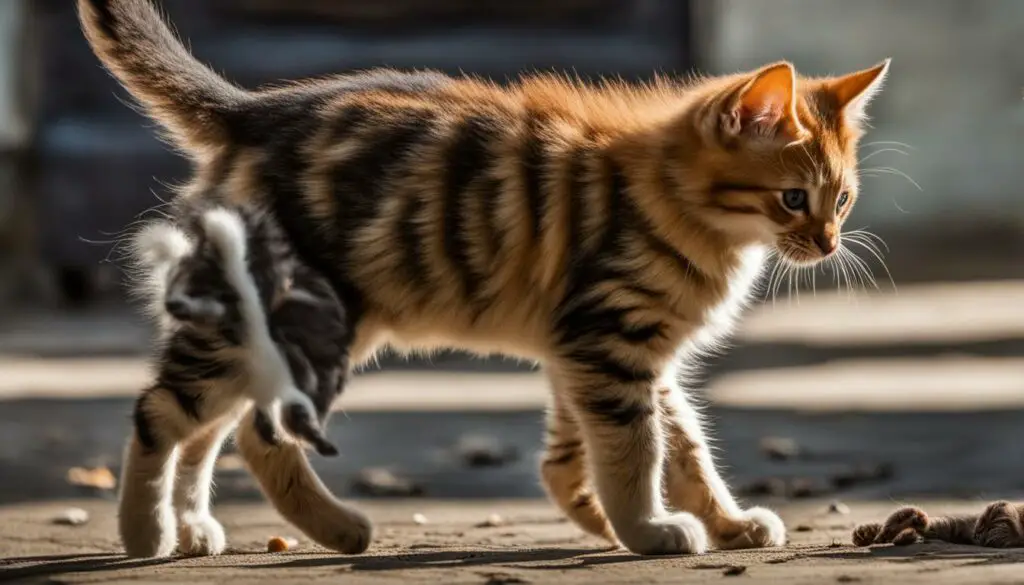Introducing a new kitten to your dog can be an exciting but challenging experience. One behavior that may arise during this process is the kitten hissing at the dog. It’s important to understand that this behavior is a sign of discomfort or fear. As a responsible pet owner, it’s essential to create a gradual introduction process to help both pets adjust to each other. By following some tips and implementing solutions, you can foster a harmonious relationship between your new kitten and dog.
Key Takeaways:
- Hissing is a natural instinct for kittens and is a way of communicating their boundaries.
- Create a separate space for the kitten with essential supplies to help them feel safe and secure.
- Familiarize your pets with each other’s scents through scent swapping and gradual introductions.
- Use rewards and positive reinforcement to build a positive association between the kitten and dog.
- Seek professional help if needed to address any challenges or concerns during the introduction process.
Why is My New Kitten Hissing at My Dog?
Introducing a new kitten to your dog can be an exciting but challenging experience. If you notice your new kitten hissing at your dog, it’s essential to understand the underlying reasons behind this behavior. Hissing is a natural instinct for cats and is often a sign of fear or discomfort. The kitten may perceive the dog as a potential threat or feel overwhelmed by the unfamiliar presence.
When your new kitten hisses at your dog, it’s crucial not to panic or force interactions. Instead, give the kitten time to adjust and create a safe and gradual introduction process. Start by keeping them separated initially and allowing them to familiarize themselves with each other’s scents. You can do this by swapping blankets or placing towels with their scents in each other’s sleeping areas. This helps them become familiar with each other’s smells and reduces initial anxiety.
Using pheromone diffusers, such as Feliway for the kitten and DAP (Dog Appeasing Pheromone) for the dog, can also be beneficial in reducing anxiety during the introduction process. These diffusers release synthetic pheromones that help create a sense of calm and relaxation for both pets.
Remember, patience and gradual introductions are key when helping your new kitten and dog build a positive relationship. With time and proper guidance, they can learn to coexist peacefully and become lifelong companions.

Common Reasons for Kitten Hissing at Dog
| Reason | Solution |
|---|---|
| The kitten feels threatened by the dog’s size or behavior. | Keep them separated initially and gradually introduce them in controlled settings. |
| The kitten is territorial and sees the dog as an intruder. | Provide the kitten with a safe space and gradually introduce their scents to each other. |
| The kitten is frightened by the dog’s presence. | Use positive reinforcement techniques and gradually increase supervised interactions. |
Tips for Introducing a New Kitten to Your Dog
If you’re bringing a new kitten into a household with a dog, it’s important to introduce them carefully to ensure they get along. Here are some helpful tips to make the introduction process smoother:
1. Create Separate Spaces
Before introducing your kitten to your dog, create a separate space for the kitten with essential supplies like a litter box, food, and water. This will give the kitten a safe and comfortable place to adjust to their new surroundings.
2. Familiarize with Scents
Allow both the kitten and dog to familiarize themselves with each other’s scents. Swap blankets or place towels with their scents in each other’s sleeping areas. This will help them become familiar with each other’s smells and reduce initial anxiety.
3. Gradual Introduction
Gradually introduce your kitten and dog to each other through visual and olfactory stimuli. Feed them on either side of a closed door, allowing them to smell each other’s presence without physical contact. This gradual approach will help them get used to each other’s presence.
By following these tips and being patient, you can help your new kitten and dog develop a positive relationship and enjoy each other’s company.
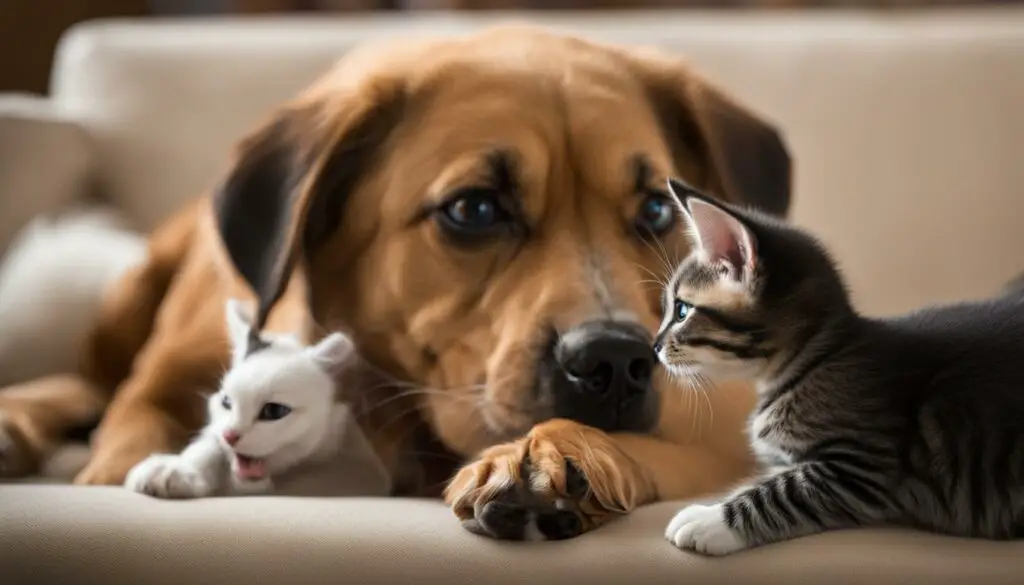
Preparing Your Dog for the New Kitten
Easing tension and ensuring a smooth introduction between your dog and new kitten requires careful preparation. By following these steps, you can help your dog adjust to the new addition to the family and create a harmonious environment:
1. Set Clear Boundaries
Before bringing the new kitten home, establish clear boundaries for your dog. Make sure they understand basic obedience commands such as “sit,” “stay,” and “leave it.” Reinforce these commands consistently to create a reliable foundation for their behavior.
2. Gradual Exposure
Help your dog become familiar with the scent and presence of the kitten before their physical introduction. Allow your dog to sniff items associated with the kitten, such as toys or blankets, to gradually acclimate them to the new scent. This gradual exposure can help reduce initial anxiety and tension.
3. Positive Reinforcement
During the introduction process, reward your dog for calm and relaxed behavior around the new kitten. Use treats, praise, and petting to reinforce positive interactions. This positive reinforcement creates a positive association with the presence of the kitten and encourages your dog to behave appropriately.
| Tips for Preparing Your Dog for the New Kitten |
|---|
| Set clear boundaries and reinforce basic obedience commands consistently. |
| Allow gradual exposure to the kitten’s scent and presence before physical introduction. |
| Provide positive reinforcement for calm and relaxed behavior around the new kitten. |
By taking these steps, you can help ease tension and create a positive environment for your dog and new kitten. Remember to always supervise their interactions, provide a safe space for the kitten to retreat to if needed, and consult with a professional trainer or behaviorist if necessary.
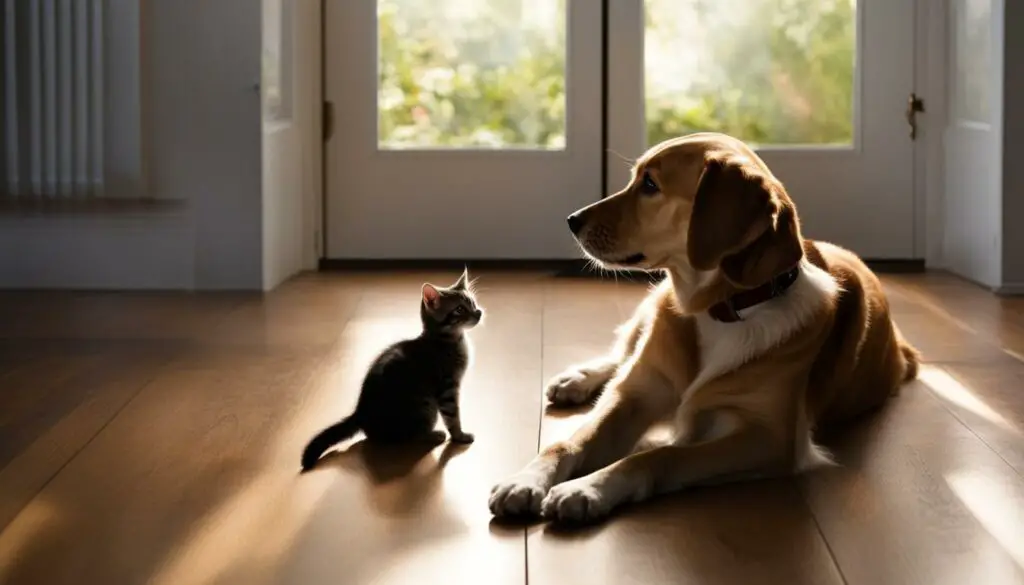
Creating a Safe Space for Your New Kitten
When introducing a new kitten to your dog, it is essential to provide a safe space for the kitten to help them feel secure in their new environment. This safe space can be created by setting up a separate room specifically for the kitten, often referred to as the kitten’s own room. In this room, you can place a comfortable bed, a litter box, and food and water bowls that are easily accessible for the kitten.
The kitten’s own room should be off-limits to the dog initially to allow the kitten to explore and settle in without feeling overwhelmed or threatened. This separation provides the kitten with a sense of security and allows them to adjust to their new surroundings at their own pace. It’s important to ensure that the kitten’s room is quiet and free from any potential stressors that may cause anxiety or fear.
Gradually introducing the dog’s scent to the kitten’s room can help the kitten acclimate to the dog’s presence in a controlled manner. You can place a blanket or towel with the dog’s scent in the kitten’s room, allowing them to become familiar with the dog’s smell without direct interaction. This scent introduction helps to create a positive association with the dog and can help reduce the initial anxiety and tension between the two pets.
By providing a safe space for your new kitten and gradually familiarizing them with the dog’s scent, you are setting the foundation for a successful introduction and helping both pets adjust to each other’s presence in a calm and controlled manner.

Familiarizing Your Pets with Each Other’s Scents
When introducing a new kitten to your dog, it’s essential to familiarize them with each other’s scents. This process helps reduce initial anxiety and tension and allows them to become more comfortable in each other’s presence. There are a few techniques you can use to facilitate this scent introduction.
1. Feeding Time
One effective method is to feed your kitten and dog on either side of a closed door. This allows them to smell each other’s presence without direct physical contact. Over time, they will start to associate each other’s scent with something positive, like mealtime, creating a positive association with their presence.
2. Blanket Exchange
Another way to familiarize your pets with each other’s scents is by swapping blankets or placing towels with their scents in each other’s sleeping areas. This allows them to become accustomed to each other’s smells in a controlled manner. It’s important to choose a blanket or towel that has a strong scent, ensuring that the exchange is effective.
3. Pheromone Diffusers
Consider using pheromone diffusers like Feliway for the kitten and DAP for the dog. These diffusers release synthetic pheromones that mimic the natural calming scents produced by cats and dogs. They can help reduce anxiety and create a more relaxed environment for both pets during the introduction process.
| Kitten | Dog | |
|---|---|---|
| Feeding Time | Feed on one side of the closed door | Feed on the other side of the closed door |
| Blanket Exchange | Place the dog’s scent in the kitten’s sleeping area | Place the kitten’s scent in the dog’s sleeping area |
| Pheromone Diffusers | Use Feliway diffuser for kittens | Use DAP diffuser for dogs |
By familiarizing your pets with each other’s scents, you’re helping them establish a sense of familiarity and comfort. This gradual introduction process sets the foundation for a positive and harmonious relationship between your new kitten and dog.
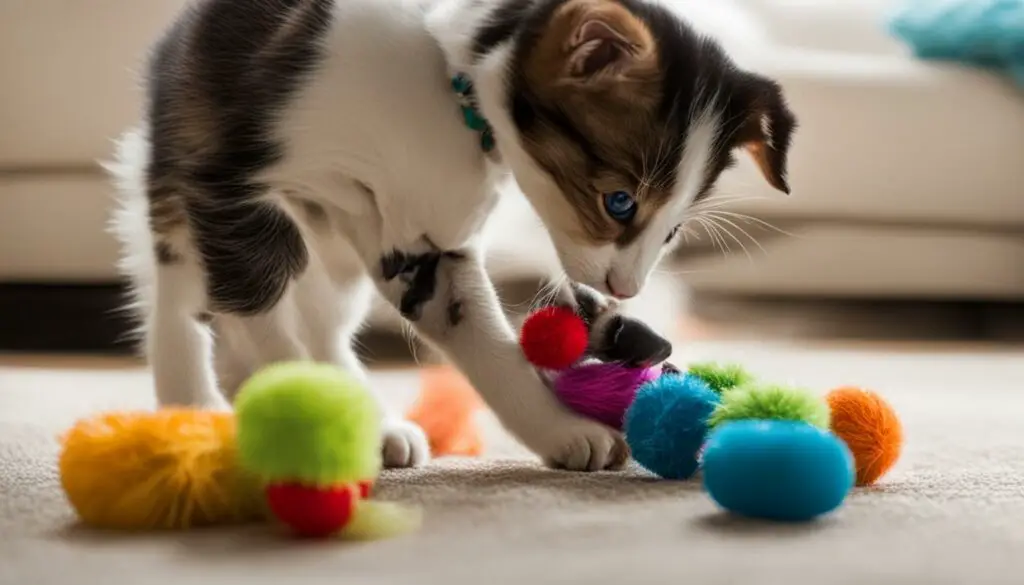
Controlled Face-to-Face Introductions
Once your new kitten and dog are familiar with each other’s scents, it’s time to proceed with controlled face-to-face introductions. This step is crucial in helping them establish a positive relationship and build trust. To ensure a smooth interaction, I recommend keeping your dog on a leash and introducing them to the kitten while she is in a cat carrier or on the other side of a baby gate. This way, they can see and smell each other without direct physical contact.

While they are in each other’s presence, observe their body language closely. Reward your dog for calm and quiet behavior near the kitten, and provide treats and praise to both pets for positive interactions. Gradually increase their supervised interactions over time, always prioritizing their safety.
It’s important to ensure that the kitten has a safe place to escape if needed, such as a cat tree or a separate room. This will give her a sense of security and control during the introductions. Additionally, prevent the dog from chasing or intimidating the kitten, as this can create a negative association and hinder the bonding process.
Remember, patience is key during this stage. Every pet is unique, and it may take time for them to adjust to each other’s presence. By taking it slow and providing positive reinforcement, you can help foster a harmonious relationship between your new kitten and dog.
Rewards and Positive Reinforcement
When introducing a new kitten to your dog, using rewards and positive reinforcement is essential for creating a positive association between the two. Reward your dog for calm and quiet behavior near the kitten, and praise both pets for positive interactions. By associating positive experiences with each other’s presence, you can encourage a harmonious relationship to develop over time.
One effective way to reward your pets is through treats. Choose small, bite-sized treats that your dog and kitten enjoy. Whenever they exhibit calm behavior or interact positively, give them a treat as a reward. This reinforces the idea that good behavior around each other is beneficial and enjoyable.
In addition to treats, verbal praise and gentle petting can also be used as forms of positive reinforcement. When your pets are behaving well together, use a cheerful tone of voice to praise and encourage them. Give them affectionate pats and scratches to show that their positive interactions are appreciated.
Remember to be consistent with rewards and positive reinforcement throughout the introduction process. By doing so, you’ll create an environment that encourages your dog and kitten to engage with each other in a positive and respectful manner.

Benefits of Rewards and Positive Reinforcement
| Benefits | Dog | Kitten |
|---|---|---|
| Reduced anxiety and stress |
|
|
| Improvement in behavior |
|
|
| Enhanced bond between pets |
|
|
Gradual Increase of Interaction
Once your kitten and dog have become comfortable with each other’s scents and have had successful controlled face-to-face introductions, it’s time to gradually increase their interaction. This step is crucial for fostering a positive and respectful relationship between your pets. However, it’s important to proceed with caution and always supervise their interactions to ensure their safety and well-being.
To gradually increase the interaction between your dog and kitten, start by allowing them to spend short periods of time together in a controlled environment. This can be done by having them in the same room with you, but still maintaining a level of separation. Keep the dog on a leash to provide an extra level of control and prevent any potential incidents. During these supervised interactions, observe their body language closely and intervene if you notice any signs of fear, aggression, or excessive stress.
As your dog and kitten become more comfortable with each other, you can gradually extend the duration of their supervised interactions. Increase the amount of time they spend together gradually, always being mindful of their behavior and emotions. It’s essential to maintain a positive and calm atmosphere during their interactions to ensure a harmonious relationship.
Remember, every pet is different, and the time it takes for them to develop a strong bond may vary. Be patient and understanding throughout the process, and celebrate small milestones along the way. With time, guidance, and your love and support, your dog and kitten can learn to coexist peacefully and become lifelong friends.
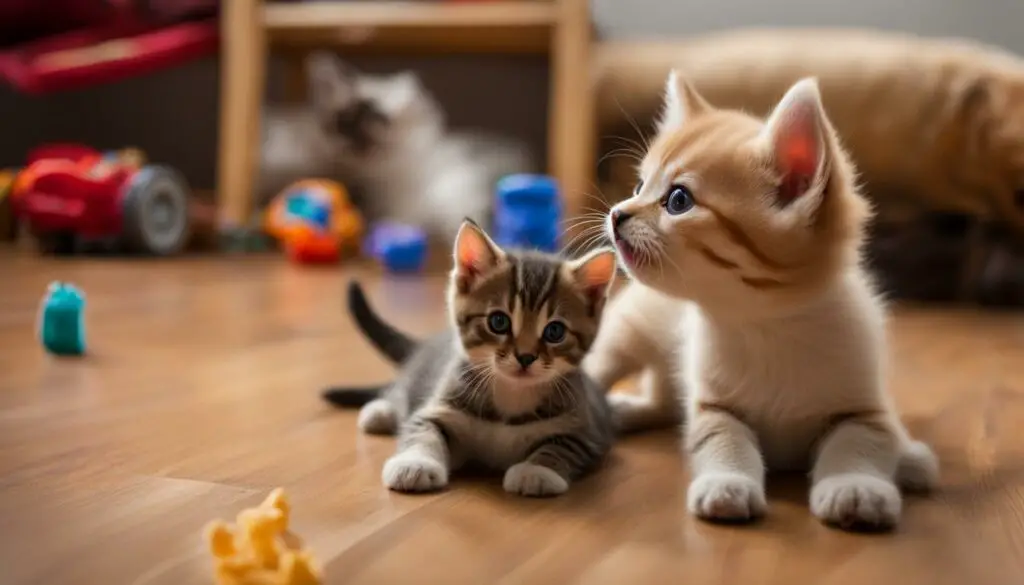
The Benefits of Gradual Introductions
Gradual introductions provide several benefits for your dog and kitten. They allow both pets to familiarize themselves with each other’s presence, scents, and behavior in a controlled and non-threatening environment. This gradual approach reduces the chances of fear, anxiety, and conflicts between the two pets.
By implementing a gradual introduction process, you give your dog and kitten the opportunity to build positive associations with each other. This strengthens their bond and increases the likelihood of them accepting and enjoying each other’s company. Gradual introductions also give you the chance to closely monitor their interactions and address any concerns or issues that may arise.
Remember that each pet is an individual with their own unique personality and temperament. Some may require more time and patience than others. By taking things slowly and gradually increasing their interaction, you set a solid foundation for a harmonious and loving relationship between your dog and kitten.
Potential Challenges and Solutions
Managing conflicts between a new kitten and a dog can be a challenging task. The process of introducing them requires patience, understanding, and careful observation. It is essential to be prepared for potential challenges that may arise during the transition period. By addressing these challenges with appropriate solutions, you can help create a harmonious relationship between your kitten and dog.
One potential challenge is aggression between the kitten and dog. This can occur if either pet feels threatened or territorial. It is important to separate them immediately and seek professional help from a veterinarian or animal behaviorist. They can assess the situation and provide guidance on how to manage aggression and create a safe environment for both pets.
Another challenge is fear or jealousy from either the kitten or the dog. It is common for pets to feel anxious or insecure when a new member is introduced into their territory. To address this, ensure both pets receive equal attention, love, and affection. Provide separate resources such as food bowls, beds, and toys to minimize competition and territorial behavior. Gradually increase their interactions under supervision, rewarding positive behavior with treats and praise.
In some cases, the kitten may continue to hiss at the dog even after a gradual introduction process. This could be a sign of ongoing discomfort or fear. It may be necessary to reassess the introduction process, consult with a veterinarian or behaviorist, and make adjustments accordingly. They can provide personalized solutions to help the kitten feel more comfortable and confident in the presence of the dog.
| Challenges | Solutions |
|---|---|
| Aggression between kitten and dog | – Separate them immediately – Seek professional help – Create a safe environment |
| Fear or jealousy from either pet | – Provide equal attention and affection – Separate resources to minimize competition – Gradually increase interactions under supervision |
| Kitten continues to hiss at the dog | – Reassess introduction process – Consult with a professional – Make necessary adjustments |
Remember, every kitten and dog is unique, and the challenges they face may vary. It is important to be flexible and patient throughout the introduction process. Seeking professional help when needed and providing a safe and positive environment will increase the chances of a successful integration between your new kitten and dog.
When Introductions Don’t Go Smoothly
Introducing a new kitten to your dog can sometimes be challenging, and it’s not uncommon for the kitten to continue hissing or showing signs of fear towards the dog. If this happens, it’s important to reassess the introduction process and make necessary adjustments to ensure a positive outcome.
One possible solution is to go back to the initial steps and give the pets more time to acclimate to each other’s presence. Keep them separated and continue with scent introductions, gradually increasing visual and olfactory stimuli. This will help them become more familiar and comfortable with each other.
If the hissing and tension persist, it could be helpful to consult with a veterinarian or animal behaviorist. They can provide further guidance and support, helping you identify any underlying issues or specific challenges that may be causing the conflict between your kitten and dog. These professionals can offer personalized solutions and strategies to resolve the conflicts and foster a peaceful coexistence.
Remember, every pet is unique, and the introduction process may take longer for some than others. Patience, consistency, and professional guidance can go a long way in helping your kitten and dog develop a positive and harmonious relationship.

Ensuring Safety and Supervision
When introducing a new kitten to your dog, it’s essential to prioritize the safety of both pets and provide proper supervision throughout the process. Managing their interactions will help prevent any potential conflicts and ensure a smooth transition to a harmonious relationship.
To ensure pet safety, it’s important to closely observe their body language during their interactions. Keep an eye out for any signs of aggression, fear, or distress from either the kitten or the dog. If you notice any concerning behaviors, intervene immediately to prevent any harm.
Additionally, it’s crucial to create a safe environment for both pets. Provide the kitten with a separate space, such as a room or designated area, where she can retreat and feel secure. This will allow her to have a personal safe space away from the dog when she needs it.
Remember, never leave the kitten and dog unsupervised until you are confident in their ability to coexist peacefully. Gradually increase their supervised interactions, always prioritizing their safety and well-being.

Benefits of Supervision
Supervision plays a vital role in ensuring the safety of both your kitten and dog. By being present during their interactions, you can intervene if any issues arise and prevent any potential conflicts. Supervision also allows you to monitor their behaviors closely, helping you identify any signs of discomfort or stress.
Furthermore, consistent supervision provides an opportunity for you to reinforce positive behaviors and reward them accordingly. By praising and rewarding both pets for calm and friendly interactions, you can encourage a positive relationship and build trust between them.
Remember, the introduction process takes time and patience. Each pet may have their own unique pace of adjustment. By prioritizing their safety and providing proper supervision, you can help create a peaceful and enjoyable environment for both your new kitten and dog.
Building a Positive Relationship Between Your Kitten and Dog
Introducing a new kitten to your dog can be an exciting but challenging experience. Building a positive relationship between them requires time, patience, and consistent effort. Here are some tips to help make your kitten and dog friends and foster a harmonious bond:
- Gradual and supervised introductions: Start by allowing them to see and smell each other’s presence without direct physical contact. Keep the dog on a leash and introduce them to the kitten while she is in a cat carrier or on the other side of a baby gate. Reward calm and quiet behavior from both pets.
- Encourage positive interactions: Engage them in play sessions together using appropriate toys and treats. This will help them associate each other’s presence with fun and positive experiences. Always supervise their interactions to ensure their safety.
- Create separate resources: Provide each pet with their own food bowls, resting areas, and toys. This will prevent competition and potential conflicts. It’s important to make sure both pets feel secure and have their own space.
- Use positive reinforcement: Reward good behavior from both pets with treats, verbal praise, and gentle petting. This will reinforce their positive interactions and help them associate each other’s presence with positive outcomes.
Remember, building a positive relationship between your kitten and dog takes time and patience. Be consistent in your approach and always prioritize their safety and well-being. With the right strategies and positive experiences, your kitten and dog can develop a strong bond and become lifelong companions.

Quote:
“The key to building a positive relationship between your kitten and dog is gradual introductions, positive reinforcement, and creating separate resources for each pet.” – Pet Lover
Building a harmonious relationship between your new kitten and dog is achievable with the right techniques and approach. By following these tips, you can create a positive environment for them to bond and become lifelong friends.
Seeking Professional Help
Introducing a new kitten to your dog can be a complex process, and sometimes it may require seeking professional help to ensure a smooth transition. Consulting a behaviorist or professional trainer who specializes in pet introductions and behavior can provide valuable guidance and support tailored to your specific situation.
These experts will assess the dynamics between your kitten and dog, identify underlying issues, and provide personalized advice to help address any challenges or concerns. They can guide you through a customized plan designed to create a positive and harmonious relationship between your pets.
Professional help can be particularly beneficial if your pets are showing persistent signs of fear, aggression, or discomfort during the introduction process. These experts have the knowledge and experience to recognize and address these behaviors, helping both pets feel safe and comfortable in each other’s presence.
Why Consult a Professional?
When it comes to introducing a new kitten to your dog, professional help can make a significant difference in the success of the integration. Here are a few reasons why you should consider seeking professional assistance:
- Expertise: Behaviorists and professional trainers have extensive knowledge and experience in understanding animal behavior, body language, and communication. They can accurately assess the dynamics between your kitten and dog, helping you understand their needs and develop effective strategies for a smooth introduction.
- Customized Solutions: Every pet is unique, and what works for one may not work for another. By consulting a professional, you can receive personalized advice tailored specifically to your pets’ personalities, temperaments, and individual challenges.
- Peace of Mind: Introducing a new kitten to your dog can be a stressful and overwhelming process. Having the support of a professional can give you peace of mind, knowing that you have someone experienced to turn to for guidance and reassurance throughout the journey.
Remember, seeking professional help is not a sign of failure but a proactive step towards ensuring a positive and successful introduction. With their expert guidance and your dedication, you can create a safe and loving environment where your kitten and dog can thrive together.
Conclusion
Introducing a new kitten to your dog can be a challenging process, but with the right approach, you can help ease the tension and create a harmonious relationship between them. It’s important to understand that hissing and other signs of discomfort are natural for a kitten when faced with a new dog. By following a gradual introduction process, you can allow both pets to adjust at their own pace and familiarize themselves with each other’s scents.
Creating a safe space for your new kitten is essential. Provide a separate room equipped with all the necessary supplies to help them feel secure. Allow the kitten and dog to get familiar with each other’s scents by swapping blankets or placing towels with their smells in each other’s sleeping areas.
Controlled face-to-face introductions should be done under supervision, with the dog on a leash and the kitten in a safe space like a cat carrier or behind a baby gate. Reward calm behavior and gradually increase their interactions. Positive reinforcement is key during the entire introduction process. By rewarding good behavior and providing separate resources for each pet, you can create a positive association between them.
If challenges persist or concerns arise, it’s always a good idea to seek professional help. A veterinarian, animal behaviorist, or professional trainer can provide personalized advice and guidance to ensure a successful integration. Remember to prioritize the safety of both pets and never leave them unsupervised until you are confident in their ability to coexist peacefully. With patience, consistency, and positive experiences, your new kitten and dog can build a strong bond and become lifelong companions.
FAQ
Why is my new kitten hissing at my dog?
When a new kitten hisses at a dog, it’s typically a sign of fear or discomfort. The kitten may perceive the dog as a potential threat or feel overwhelmed by the unfamiliar presence. Hissing is a natural instinct for cats and serves as a way to communicate boundaries and assert themselves.
How can I help my kitten and dog get along?
To help your kitten and dog get along, it’s important to create a gradual introduction process. Start by keeping them separated and allowing them to familiarize themselves with each other’s scents. Use pheromone diffusers to reduce anxiety. Eventually, you can introduce them face to face with supervision and positive reinforcement.
How can I prepare my dog for the new kitten?
To prepare your dog for the new kitten, give them plenty of attention and praise to reassure them that the kitten is not a threat. Make sure your dog understands basic obedience commands and is well-socialized. Consult with a professional trainer if needed.
How do I create a safe space for my new kitten?
Set up a separate room for the kitten with essential supplies like a bed, litter box, and food and water bowls. This room should be off-limits to the dog initially to allow the kitten to explore without feeling overwhelmed.
How can I familiarize my kitten and dog with each other’s scents?
Familiarize your kitten and dog with each other’s scents by swapping blankets or placing towels with their scents in each other’s sleeping areas. You can also feed them on either side of a closed door to allow them to smell each other’s presence without physical contact.
How do I introduce my dog to the kitten face to face?
Introduce your dog to the kitten face to face with supervision. Keep the dog on a leash and introduce them while the kitten is in a cat carrier or on the other side of a baby gate. Reward the dog for calm behavior and gradually increase their supervised interactions.
How can I reward and reinforce positive behavior during the introduction process?
Use treats, verbal praise, and gentle petting to reward and reinforce positive behavior during the introduction process. This will help create a positive association between the dog and kitten’s presence.
How should I gradually increase the interaction between my kitten and dog?
Gradually increase the interaction between your kitten and dog by allowing them to spend short periods of time together in a controlled environment. Observe their body language and intervene if necessary. Reward positive behavior and gradually extend the duration of their supervised interactions.
What should I do if there are challenges between my kitten and dog?
If there are challenges between your kitten and dog, separate them and consult with a professional trainer or behaviorist for guidance. They can provide specific strategies and techniques to address individual challenges and ensure the safety of both pets.
What can I do if the introductions don’t go smoothly?
If the introductions don’t go smoothly, reassess the introduction process and make necessary adjustments. Consult with a veterinarian or animal behaviorist for further guidance and support to help the kitten and dog coexist peacefully.
How can I ensure the safety of my kitten and dog during their interactions?
Always supervise their interactions, especially in the early stages. Keep a close eye on their body language and intervene if you notice any signs of aggression, fear, or distress. Provide a safe space for the kitten to escape if needed, and prevent the dog from chasing or intimidating the kitten.
What can I do to build a positive relationship between my kitten and dog?
Building a positive relationship between your kitten and dog requires time, patience, and consistent positive reinforcement. Encourage positive interactions, provide separate resources, and reward good behavior. With time and positive experiences, they can develop a strong bond and become lifelong companions.
Should I seek professional help for the introduction process?
If you encounter persistent challenges or concerns during the introduction process, it may be beneficial to seek professional help. Consult with a veterinarian, animal behaviorist, or professional trainer who specializes in pet introductions and behavior. They can provide personalized advice and guide you through a customized plan tailored to your pets’ needs.

